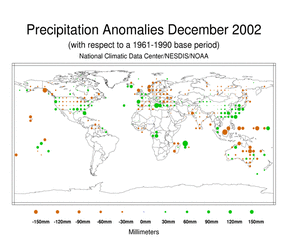Global Highlights:
|
Contents of this Section: |
The data presented in this report are preliminary. Ranks and anomalies may change as more complete data are received and processed. The most current data may be accessed via the Global Surface Temperature Anomalies page.
Introduction
| The December 2002 mean temperature was above the 1988-2002 average across much of North America, northwestern Africa, southwestern Europe, India and southeast Asia as shown in the adjacent map of blended satellite and in situ data. Cooler than average temperatures were noted over a large area of Asia including most of Russia and eastern Europe, as well as much of Argentina. The mean position of upper level ridges and troughs of low pressure depicted by positive and negative 500 millibar height anomalies), are generally reflected by areas of positive and negative temperature anomalies at the surface, respectively. Warmer-than-average sea surface temperatures were observed throughout the tropical Pacific, the signature of El Niño conditions. |
 larger image |
 larger image |
December temperature anomalies calculated from the Global Historical Climatology Network data set of land surface stations using a 1961-1990 base period show above average temperatures throughout Canada, Alaska and much of the northern United States, where monthly temperatures were 4-6°C (7.2-10.8°F) above the mean. Notable cool anomalies were present throughout much of Asia, where monthly temperatures were up to 4-6°C (7.2-10.8°F) below average. |
Temperature
December
|
 larger image |
|
 larger image |
Precipitation
|
 larger
image larger
image |
References:
Peterson, T.C. and R.S. Vose, 1997: An Overview of the Global
Historical Climatology Network Database. Bull. Amer. Meteorol.
Soc., 78, 2837-2849.
 NOAA's National Centers for Environmental Information
NOAA's National Centers for Environmental Information